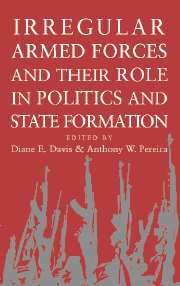Book contents
- Frontmatter
- Contents
- Contributors
- Irregular Armed Forces and Their Role in Politics and State Formation
- Introduction
- Part I The Basic Framework and Beyond
- 2 Armed Force, Regimes, and Contention in Europe since 1650
- 3 Limited War and Limited States
- 4 Where Do All the Soldiers Go?
- 5 Military Mobilization and the Transformation of Property Relationships
- Part II Deconstructing Armed Forces
- Part III Not Just the Nation-State
- Conclusion
- Index
4 - Where Do All the Soldiers Go?
Veterans and the Politics of Demobilization
Published online by Cambridge University Press: 23 November 2009
- Frontmatter
- Contents
- Contributors
- Irregular Armed Forces and Their Role in Politics and State Formation
- Introduction
- Part I The Basic Framework and Beyond
- 2 Armed Force, Regimes, and Contention in Europe since 1650
- 3 Limited War and Limited States
- 4 Where Do All the Soldiers Go?
- 5 Military Mobilization and the Transformation of Property Relationships
- Part II Deconstructing Armed Forces
- Part III Not Just the Nation-State
- Conclusion
- Index
Summary
The positive relationship between war and state formation in Europe has been well established (Finer 1975; Mann 1988, 1993; Tilly 1990; Porter 1994). Its logic is contained in the “extraction-coercion cycle” discussed by Finer. States use coercion to extract military resources — men, money, and matériel — which increase their coercive powers for later rounds of extraction. States grew around the need to organize both coercion (armies and their supply) and extraction (taxation, requisition, conscription). Through this process, war served as a mechanism of natural selection for the hundreds of statelike entities in fifteenth-century Europe. Those states adapting in ways that allowed them to ride the upward spiral of the coercion-extraction cycle have survived; the rest have been swallowed up.
This model of state formation emphasizes mobilization (extraction in preparation for war) over demobilization. To a degree this is justified. Mobilization is a risky proposition from the perspective of states and ruling classes, in part because the extraction of men, money, and matériel can engender resistance from subjects (Tilly 1990: 99–103). One way of reducing effective resistance is to monopolize the means of coercion. Thus, Tilly argues that disarming subjects was central to the process of state formation. States monopolized the use of force by building up “fearsome coercive means of their own as they deprived civilian populations to access to those means” by making it “criminal, unpopular, and impractical for most of their citizens to bear arms” (Tilly 1990: 70).
- Type
- Chapter
- Information
- Publisher: Cambridge University PressPrint publication year: 2003
- 2
- Cited by

